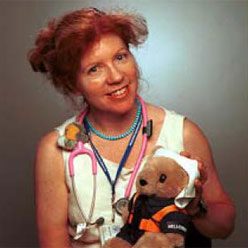

Ella Scott, RN, RSCN, BA, MA, Grad Cert Pediatric Intensive Care
Ella Scott is a nurse consultant/lecturer with over 20 years of pediatric nursing experience. Her background includes nearly 10 years with N.E.T.S. (New South Wales Neonatal & Emergency Transport Service), extensive experience in Pediatric & Neonatal intensive care, and Emergency Department Pediatrics. Ella currently is the nurse consultant for the pediatric emergency department at Sydney Children's Medical Center and also coordinates the P.E.T.A.L.S. (Pediatric Emergency Training in Advanced Life Support) course at Sydney's Royal North Shore Hospital. She continues to be involved with pediatric simulation based training utilizing the technology of the Sydney Medical Simulation Centre.
Ella has written & presented extensively on pediatric transport, emergency pediatrics, and simulation technology. In recognition of nursing excellence within this area, Ella was recently awarded a N.R.B. New South Wales Scholarship to attend & present a paper in Beijing at the 23'rd World Congress of Pediatrics.
She currently lives in Sydney, Australia & lecture topics include: The Ouchless Emergency Department, Pain management for procedures, Stabilization & resuscitation prior to transport, pediatric trauma management, & the use of simulator technology in pediatrics.
Speaking Topics
Simulation Technology in Pediatric Emergency Training
Pediatric cardiac arrest is often an avoidable disaster. Sudden unexpected cardiac arrest in a child is relatively rare with more likelihood of warning signs of deterioration presenting initially.
An advanced pediatric resuscitation course was devised and instigated at Royal North ShoreHospital, Sydney four years ago. The main objective is being to educate residents, registrars, and nurses in effective and efficient management of pediatric emergencies. The course is run over an eight-hour day alternating lectures and workshops. More recently the course has progressed in to a differing learning environment with the use of the virtual Pediatric patient utilizing the technology from the Sydney Simulation Centre. There is an emphasis on teamwork and crisis resource management in the emergency situation. Examples of human performance issues are examined through case scenario exercises and the use of video debriefing.
Course length: 8-hours in Sydney, Australia
Course length: 2-hour overview (locations outside of Sydney)
Intended audience: Paramedics, ER, Pediatric, Critical Care Nurses, & Respiratory TherapistsTiny Tots Trauma Training: A course that deals only with aspects of pediatric trauma
Injury is one of the most significant health problems affecting children in the western world and is the leading cause of death for all children over one year of age. The survival of children who sustain major trauma or life threatening trauma depends on the resuscitation in the emergency department and access to emergency surgery.
The principles of managing pediatric trauma victims are much the same as for adult patients however particular aspects of resuscitation and management require detailed attention because of the anatomical differences encountered in children.
The following objectives will be addressed throughout the day:
• Early assessment, resuscitation and management of the injured child
• Specific characteristics in managing the pediatric airway
• Practical skills in airway and vascular access
• Specifics of pediatric burns management
• An understanding of infant trauma
• The role of the Trauma team in relation to communication, situational awareness and human performance factors.
• The use of ultrasound in childrenPediatric trauma is a disease entity that challenges our capacity for teamwork. This will be explored further in scenario based sessions.
The concept continuum of care facilitates an efficient and effective method of treating and managing these children from the initial site of injury to the resuscitation room through to the intensive care unit and the rehabilitation process. Essential components that contribute to continuum of care are education, research, and outcome analysis. It is our objective to enhance pediatric trauma training to assist medical, nursing and ambulance personnel involved with treatment management and care of these children.
Course length: 8 hours
Intended audience: Paramedics, ER, Pediatric, Critical Care Nurses, & Respiratory TherapistsTaking the Ouch Out of Emergency Department Procedures
Over the past decade, new medication choices and combinations have revolutionized the way analgesia and sedation is delivered. Painful procedures are often carried out on children as a therapeutic necessity. Many of these children would have already experienced painful injuries enhanced by anxiety and fear. Inadequately relieved pain produces psychological and physiological reactions, which may carry long term consequences of a disturbing experience. By effective utilization of current pharmacological agents eradication of a child's pain, amnesia, and effective sedation lead the path to an ouchless Emergency Department.
Advantages of effective analgesia and sedation include facilitation of procedures such as laceration repair, lumbar puncture, and burns dressings. Children undergoing investigations such as C.T. scanning may require sedation anxiolysis only as this procedure is uncomfortable but painless. Parents stress levels are reduced in observing that their child is not experiencing unnecessary pain, this in turn improves their acceptance of rendered care.
This two-hour session explores current pharmacological and non-pharmacologic options along with distraction techniques to help our patients through their hospital experience.
Course length: 2 hours
Intended audience: Paramedics, ER, Pediatric, Critical Care Nurses, & Respiratory TherapistsStabilization and Resuscitation Prior to Transport
Transporting the critically sick neonate or child is a challenge to emergency personnel requiring specialist knowledge, skills and age appropriate equipment suitable for all ages. In Sydney regionalized tertiary centers provide specialized care for specific illnesses in specific age groups. Often, it is imperative to transport a sick child or neonate to one of these centers where specialized medical and nursing care plus particular technical and diagnostic facilities are provided. This three hour session explores some of the pitfalls associated with transporting critically sick infants and children alongside essential stabilization measures to avoid disastrous consequences. Case scenarios will be examined and critiqued to enhance learning outcomes.
Course length: 3 hours
Intended audience: Paramedics, ER, Pediatric, Critical Care Nurses, & Respiratory Therapists